Over the years, a range of mainly industry-led initiatives have emerged as brands continue to make voluntary commitments to reduce their emissions and lessen the impact of their raw materials. However, transparency of key information by companies and accountability for poor corporate practices, continue to be problems. While many brands now have wide-ranging climate commitments, the industry continues to project more growth over the coming years.[43] There are still no reliable statistics on how much is being produced or what the overall climate impact of the industry is.[44]
Industry-level data remains unreliable and outdated. In 2022, potentially misleading sustainability claims made by brands including H&M using the global Higg[45] Material Sustainability Index (MSI) data led to accusations of greenwashing by activists. The Norwegian Consumer Authority, in a case involving a Norwegian company, ruled that Higg MSI data could not be used in product marketing.[46] H&M subsequently withdrew the data from its website. At a brand level, demands are growing to increase supply chain transparency, and while a small number of brands (e.g. Eileen Fisher) now offer transparency as far as Tier 4 in their supply chains, this remains the exception rather than the rule.
Transparency and supply chain accountability, regarding both environmental and social issues, are the primary ideas behind proposed changes to the fashion apparel industry’s regulatory environment.
In the last 18 months, more governments at all levels have started to put the fashion industry on notice that business practices need to change. Bills in Europe seek to improve environmental labeling and increase circularity. Those in the US work to increase supply chain accountability and improve garment workers’ working conditions with the FABRIC Act and New York Fashion Act.[47] While 2022 also saw movement from industry-led voluntary initiatives, including the UN Fashion Charter and Sustainable Apparel Coalition (SAC), which raised decarbonisation goals, it is clear that voluntary measures alone are now too little, too late to meet the scale of the industry’s impact. Swift action from regulators, support and leadership from brands and suppliers, and the input of suppliers, workers, and other agents of change in manufacturing countries are all urgently needed to rapidly and justly decarbonise the fashion industry at scale.






